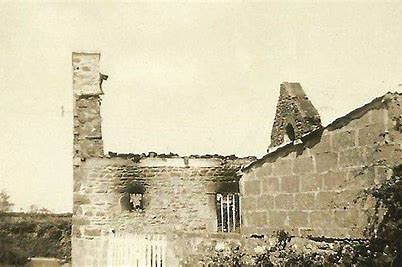NEWSLETTER 4 – 2004
By Roger Stanton
The House of Alphonse is well known by the Brittany Resistance and by former veteran members of the Shelburn Escape Line in Brittany. The house was situated on the cliffs near Plouha, and was the last safe-house on the line before escapers and evaders made their way down the steep cliffs in darkness to be extracted by men of the 15th Flotilla’s Motor Gun Boats and returned to England. The final pick-up from the safe-house nearly ended in disaster!
On the night of 23 July 1944, Shelburn’s leader, Lucien Dumais, together with Francois Le Cornec, took five evaders to the Maison D’Alphonse, the home of safe-house keepers Jean and Marie Gicquel. The guides left the house at 0200hrs. The evaders, Maj Oswald Cary Elwes SAS, Maj Smith SAS, Cpl Mills SAS, F/Sgt TP Fargher 234 Squadron RAF, and Maj A Jones USAAF, were to remain in hiding at the house until the next evening.
Shortly after the group’s arrival, a patrol of German soldiers, together with Russians serving in the German army, came near to the house. They were menacingly drunk, and something had attracted their attention to the house. They banged on the door and Jean Giquel unsuspectingly opened it to them. Panic stricken, and expecting the worst, he slammed the door shut, locked it and warned the evaders in the kitchen, who quickly went into hiding in the attic taking their weapons with them, as under Hitler’s ‘Commando Order’ the men would have been shot if captured.
The Russians forced their way in and dragged Jean Gicquel outside, leaving Marie and their baby inside. Bursts of machine-gun fire were heard, and everyone feared for Jean’s life. Thankfully, the drunken Russians had merely fired around haphazardly, resulting in the German patrol commander being shot in the groin! Jean was then escorted to the house of a neighbour to requisition a cart to carry the wounded soldier. Other soldiers stayed with Marie and her six week old baby Marie-Therese in the house.
On hearing the shooting Dumais and Le Cornec returned to the house to witness events from a safe distance. As all had gone quiet the evaders thought that the soldiers had left; one moved, the agitated Russians heard a sound, and threatened to shoot the baby. Eventually they calmed down when the other soldiers returned with the cart. The wounded man was loaded onto the cart and they all left.
After a quick discussion it was decided that they must all leave the house immediately. Jean hid the evaders in a cornfield and took his wife and child to a neighbouring safe-house farm. He then made contact with Dumais and le Cornec and later in the day they searched for their evaders. On return to their barracks the patrol informed the Gestapo of the incident, who then returned with troops to search the house. No-one was found, and the House of Alphonse was razed to the ground on the morning of Sunday 24 July 1944, but by then the evaders and the Gicquel family had moved on to other safe-houses.
In the early morning of Monday 25 July, at 0300hrs, Jean and the five evaders were taken down the steep cliffs by a young girl courier who used a knitting needle to locate mines along the route down to the beach and the waiting ‘fol boats’, covering the mines with white handkerchiefs to indicate the danger areas to avoid. At the water’s edge, she left the men to embark on their waiting boats and returned along the beach, collecting her handkerchiefs, before climbing the steep cliffs and returning home. The men left France from Bonaparte Beach, and were taken back to England by MGB 502 (Operation Crozier ll). By noon they were in London. Two weeks later the SAS evaders parachuted back into Brittany.
Marie, and baby Marie-Therese were looked after by the Shelburn Line and remained in safe-houses until the liberation. A large stone block, taken from the ruins of the House of Alphonse, was later engraved with the BBC code message to the Shelburn Line, ‘Bonjour tout le monde à la Maison d’Alphonse’. It was presented to the ELMS Director on completion of one of the sponsored ‘Home Run’ events and now resides, on loan, in the Memorial Chapel at Eden Camp WW2 Museum, at Malton, near York.

